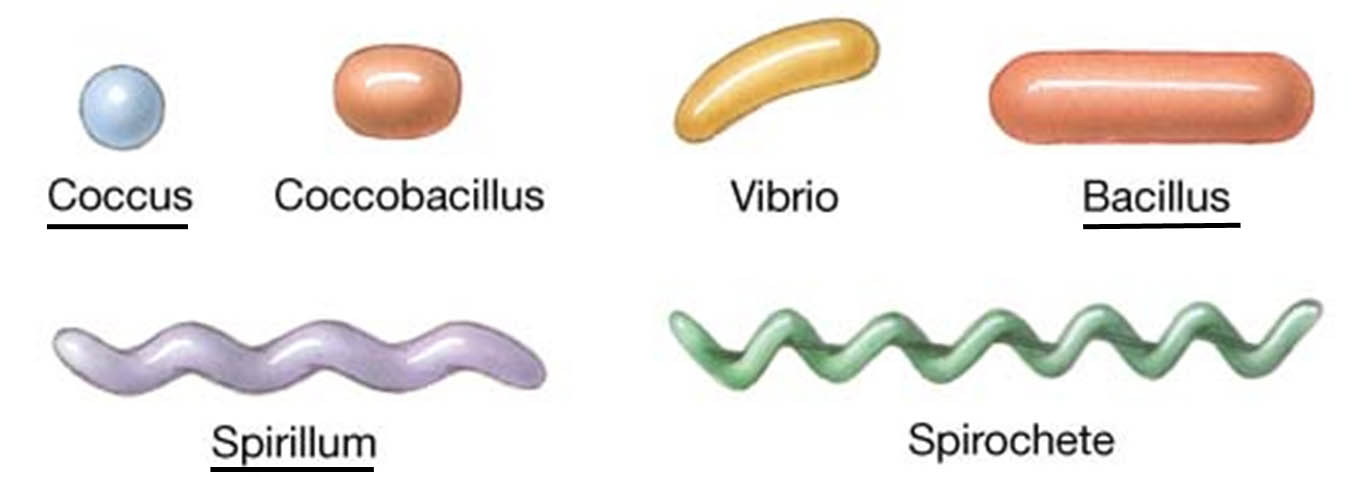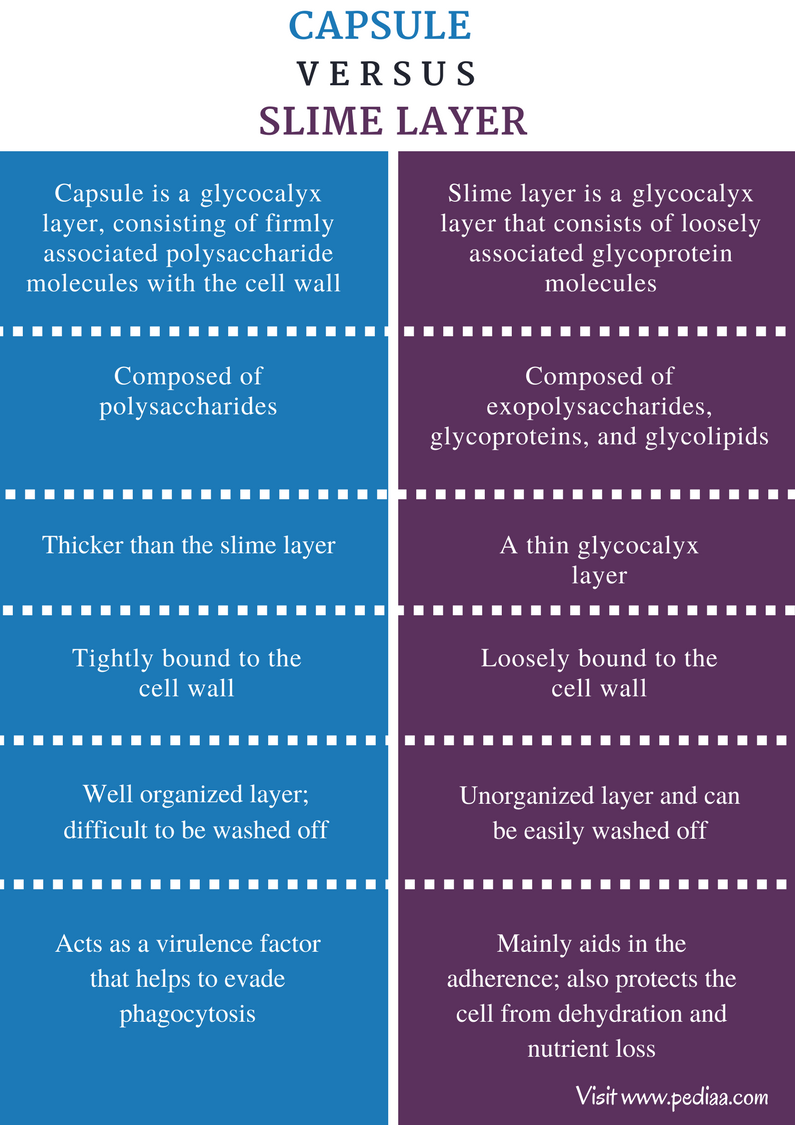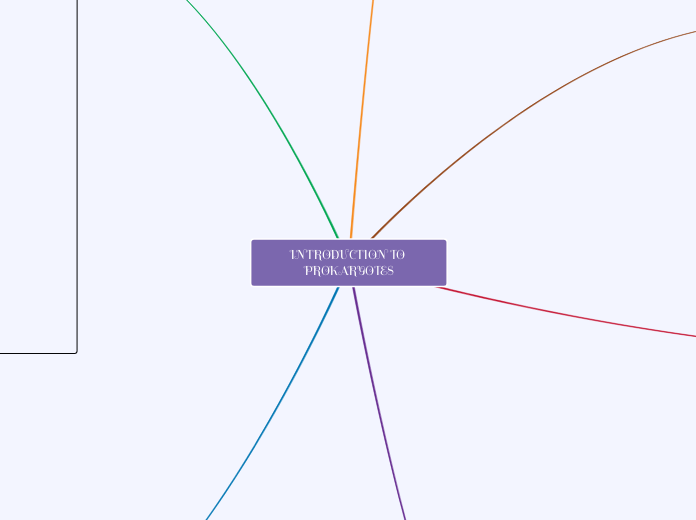INTRODUCTION TO PROKARYOTES
What is prokaryotes ?
The prokaryotes are a group of organisms that lack a cell nucleus (=karyon), or any other membrane-bound organelles.
Size, shape & arrangement
size
0.2 to 2.0 µm in diameter and 2 to 8 µm in length.
shape
Coccus Bacillus Spiral

additional shapes: *star-shaped *square *triangular
arrangement
Cocci: *diplococci (pairs), *staphylococci (grape-like clusters), *streptococci (chains), *tetrads (4 cocci in a square), *sarcinae (cubic configuration of 8 cocci)
Bacilli: *diplobacilli (two bacilli) *streptobacilli (chains of bacilli) *palisades (rods side by side or in X, V or Y figures)
Spiral: *vibrio *spirillum (rigid spiral shape) *spirochetes (flexible and undulating)
Atypical cell walls
Mycoplasma *no walls or have very little wall material *membrane contains sterols *smallest known bacteria *can pass through most bacterial filters Chlamydiaceae *two membranes *some genes for peptidoglycan syhthesis found in genome *obligate intracellular parasites *non-replicative elementary body form has extensive crosslinking in outer membrane proteins Archaea *lack peptidoglycan in their cell walls
Archaea
*some species have cell walls consisting of polysaccharide, glycoprotein, or protein but not peptidoglycan *contain a substance similar to peptidoglycan called pseudopeptidoglycan *most common wall type is paracrystalline surface layer (S-layer) *archaea are naturally resistant to lysozyme and penicilin
S-layer -surface or outermost layer forming "lipidless membrane" -found on Archaea, a few G+, G- -composed repeating subunits of protein or glycoprotein -protects against osmotic stress, pH, enzymes -may aid in attachment and inhibit phagocytosis
cell wall of Gram -ve Archaea -a layer/2 of thick protein or glycoprotein outside plasma membrane
cell wall Gram +ve Archaea -pseudomurein -L-amino acid -N-acetyltalosaminuronic acid
Structure external to the cell wall
Glycocalyx
*substances that surround cell *made inside cell & excreted to the cell surface *if organized & firmly attached to the cell - capsule *if unorganized & only loosely attached to the cell wall - slime layer *a glycocalyx made of sugar is called an extracellular polysaccharide (EPS)

Difference between capsules & slime layer
Functions of glycocalyx; *protection from phygocytosis *attachment to various surfaces *source of nutrients *protect a cell against dehydration
Flagella
*threadlike, locomotor appendages exteding outward from plasma membrane & cell wall Functions; -motility & swarming behavior -attachment to surfaces -may be virulence factors

Types of flagella
Types of motility -"run" or "swim" -"tumbles" -"swarm"
Axial filaments(endoflagella)
*bundles of fibrils that arise at the ends of the cell beneath the outer sheath *spiral around the cell *present in spirochetes group of bacteria
Fimbriae and Pili
*hairlike appendages that are shorter, straighter & thinner than flagella *consist of a protein called pilin arranged helically around a central core *used for attachment rather than for motility
Fimbriae -can occur at the poles of the bacterial cell -can be evenly distributed over the entire surface of the cell -can number anywhere
Pili -longer than fimbriae -only one or two per cell -preparation for the transfer of DNA from one cell to another -also called sex pili
The cell wall
*surrounds the cytoplasmic membrane *not a regulatory structure *not selectively permeable
Composition & characteristics of cell wall
-composed of a macromolecular network called peptidoglycan (also known as murein) -peptidoglycan consists of a repeating disaccharide -disaccharide portion is made up of monosaccharide called N-acetylglucosamine (NAG) & N-acetylmuramic acid (NAM)
Functions of cell wall; *prevent bacterial cell from rupturing caused by water pressure *contributes to pathogenicity *classification *maintains characteristic shape *provides a rigid platform *counters the effects of osmotic pressure
2 major types of walls -Gram-positive -Gram-negative

